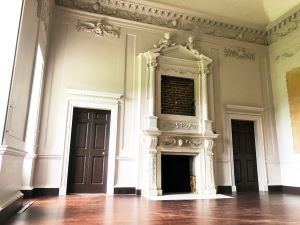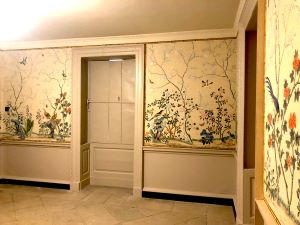Visitors return to Marble Hill House following completion of restoration project
 Following an extensive restoration completion in the autumn of 2021 by Universal Stone Ltd., English Heritage visitors can now explore the rooms that Henrietta Howard walked and greeted her social circle at Marble Hill House in Twickenham. Historically described as one of the jewels in London’s crown, Marble Hill is an early 18th-century Georgian masterpiece, built for the Prince of Wales’s mistress, Henrietta. Constructed between 1724-1729 by architect Roger Morris, it is one of the earliest examples of Neo-Palladian style in the country.
Following an extensive restoration completion in the autumn of 2021 by Universal Stone Ltd., English Heritage visitors can now explore the rooms that Henrietta Howard walked and greeted her social circle at Marble Hill House in Twickenham. Historically described as one of the jewels in London’s crown, Marble Hill is an early 18th-century Georgian masterpiece, built for the Prince of Wales’s mistress, Henrietta. Constructed between 1724-1729 by architect Roger Morris, it is one of the earliest examples of Neo-Palladian style in the country.
Universal Stone Limited (USL) were pleased to be engaged by English Heritage to undertake various elements of restoration works to Marble Hill. As heritage restoration and construction specialists, USL acted as Principal Contractor in collaboration with Acanthus Clews Architects to restore the interior and exterior, returning it to its opulent Georgian splendour. This ambitious Revived project was awarded grants of over £4m by The National Lottery Heritage Fund and the National Lottery Community Funds, focusing on renovation works to the house and grounds with the intention of opening them up for the public to enjoy.
The condition of the house was run down and needed extensive work to numerous internal and external components. Before the Revived project started, the site had seen little investment since the 1980s. Opening times for the historic house were limited and much of the park’s original character had been lost.
The necessary external repair programme included:
- Full external repairs, redecoration of rainwater goods, drainage, and roofing
- Restoration to the existing gilded weathervane
- Restoration to dormer windows incorporating external timber surfaces, joinery repairs and replacement of leadwork ridges
- Stucco conservation including masonry, repairs to decayed capitals, mortar repairs
- New electrical and water services

The external building received a respectful conservation and refresh, in alignment with the overall vision to amplify the site’s unique heritage and local popularity to create a sustainable future for the building and surrounding park. USL's conservation philosophy was to proceed with only minimal/necessary repairs to historic fabric, whilst carefully maintaining and enhancing the weather proofing of the structure.
 Inside, conservation to return the house to its former Georgian splendour was largely concentrated on the room interiors and improvements. Andrew Jackson (USL Senior Commercial Manager) added, “The main driver for this project was to investigate the interior surfaces to find the correct Georgian paint shades.” Working with the client, the team undertook spectrographic analysis to colour-match the paint and finishes – up to 30 layers of paint on surfaces. This allowed the ‘Great Hall’ to return to a surprisingly subdued palette of off-white, accentuating the carvings and contrasting against the chocolate-brown doors and skirting. The team discovered that the existing glitzy gold leaf cornices, statutes, pillars, and decorative fireplace – were not historical, but were added later. The team assisted in developing a scheme to mask/paint over this detailing and repaint in the original off-white shade. The painting application was designed to be reversible in the future.
Inside, conservation to return the house to its former Georgian splendour was largely concentrated on the room interiors and improvements. Andrew Jackson (USL Senior Commercial Manager) added, “The main driver for this project was to investigate the interior surfaces to find the correct Georgian paint shades.” Working with the client, the team undertook spectrographic analysis to colour-match the paint and finishes – up to 30 layers of paint on surfaces. This allowed the ‘Great Hall’ to return to a surprisingly subdued palette of off-white, accentuating the carvings and contrasting against the chocolate-brown doors and skirting. The team discovered that the existing glitzy gold leaf cornices, statutes, pillars, and decorative fireplace – were not historical, but were added later. The team assisted in developing a scheme to mask/paint over this detailing and repaint in the original off-white shade. The painting application was designed to be reversible in the future.
The interior scheme integrated a programme of internal repairs and restoration such as introducing a platform lift to improve accessibility for all, new joinery, staircase strengthening, windows and doors, new kitchenette, plastering, redecoration and the refurbishment of the toilet corridor and WC facilities.

Andrew Jackson commented, “The programme required meticulous planning – and the project saw numerous variations that were discovered whilst the works were already underway. These were carefully added to the schedule including elements such as a new central heating system. We could incorporate and make efficient use of the existing historical chimneys and fireplaces, to create an invisible central heating system.”
Mechanical and electrical works were a substantial part of the overall improvements ranging from the complete electrical replacement with upgrades to wiring, lighting, and environmental monitoring systems.

As a conservation project, Marble Hill House presented complexities and a wide spectrum of specialisms. “The team's commitment to high craftsmanship and the sympathetic restoration was extremely commendable.” highlighted Andrew Jackson, USL Commercial Manager.
Visitors can now explore the rooms that Henrietta once frequented, from the classically inspired Tetrastyle Hall which was used for games and socialising, to her personal bedchamber, grandly decorated with green silk and tall white columns. Henrietta’s dining parlour is now a more vibrant space, adorned with Chinese wallpaper, and her great-niece’s bedchamber is painted in a historically accurate ‘peach blossom’ shade.
 When the house reopened in the spring of 2022, Marble Hill saw its visitor numbers shoot up a staggering 900 percent compared to when it was fully operational in 2019, a time when access was limited and available by pre-booked guided tours only. Now it is completely open to the public without pre-booking and is free to visit.
When the house reopened in the spring of 2022, Marble Hill saw its visitor numbers shoot up a staggering 900 percent compared to when it was fully operational in 2019, a time when access was limited and available by pre-booked guided tours only. Now it is completely open to the public without pre-booking and is free to visit.
English Heritage says that Marble Hill tells the story of its 'remarkable' owner, Henrietta Howard, Countess of Suffolk, and her life in Georgian society. Outside, there are over 60 acres of riverside parkland with restored gardens and woods and even the remains of a historic nine-pin bowling alley dating back more than 250 years.
The entire team at USL are rightfully proud of the end result, showcasing the talents of our restoration specialists, artisans, and tradespeople. The project's intricacy utilised a sensitive balance of modern and traditional techniques to bring the story of Marble Hill House back to life.
For further information visit universalstone.co.uk
Martin Thomas Associates Ltd were appointed to undertake all the Mechanical and Electrical Consultancy work from initial feasibility to detailed design, including input to the HLF Stages 1 and 2 submissions. Below are some of the lighting designs.

For more from this company visit www.mtassoc.co.uk















